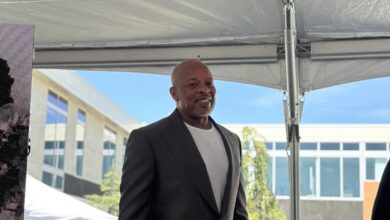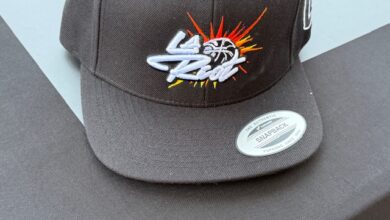Looking Ahead: Hospital Chief Talks New Role

Michelle Gaskill-Hames became president of the Kaiser Permanente region that includes Los Angeles County in September after serving on an interim basis since April.
It’s a huge job. Kaiser Permanente is Los Angeles County’s largest private-sector employer with more than 44,700 workers here, according to the Business Journal’s list of largest employers published in August. But the region she presides over is larger than Los Angeles County and her total employee count is about double that number.
And she’s already had to confront big issues. Since her region includes Hawaii, Kaiser Permanente was in the midst of the emergencies caused by devastating wildfires in Lahaina, and she had to deal with labor issues that led to a deal in October to give workers a 21% wage increase over four years.
The Business Journal caught up to Gaskill-Hames in her Pasadena office to ask about those issues and several others.
The 50-year-old mother of three, whose official title is president of Kaiser Permanente Southern California and Hawaii, Health Plan and Hospitals, started out as a nurse in Detroit, got interested in health care inequities and moved into management.
As for living in Los Angeles, she said she and her husband, a bishop in the Christian Methodist Episcopal Church, love to travel and eat out. She describes Los Angeles as “a great place to explore fine dining.”
Tell us about your professional background.
I started my career as a registered nurse in Detroit, working in the neonatal intensive care unit. There, I saw the stark realities of health care disparities up close. I directly witnessed the impact of deficiencies in the social determinants of health, such as housing and food insecurity, on patient outcomes. This experience led me to pursue a degree in health care administration to become involved in shaping and improving systems of care to address health inequities.
I had progressive leadership roles in multiple health systems before becoming the president of a hospital on the south side of Chicago, providing health care in an underserved community with limited access to care. The experience of bringing this hospital to financial solvency while addressing health disparities and strengthening our quality was exhilarating. It was a full-circle experience that connected me to my “true north” commitment to address health care inequities.
And your career with Kaiser?
I joined Kaiser Permanente in 2016 and have held several executive roles including leading three of our Northern California hospitals, serving as a regional chief nurse executive and regional chief operating officer.
I am privileged and excited to now serve as the regional president of Kaiser Permanente Southern California and Hawaii. I am excited to support our 17 medical centers, 216 medical office buildings and our 87,000 amazing team members. There is significant opportunity for us to build on our rich history as the largest nonprofit value-based health system in the country. I’m enthusiastic about where we are today and where we can go to elevate access and convenience for our members.
Have Kaiser Permanente hospitals in your service territory rebounded fully from the impacts of the pandemic?
Kaiser Permanente faced difficult challenges during the pandemic. I am especially grateful to our physicians, nurses and employees who gave their all to meet the needs of our patients at great personal sacrifice. Many experienced burnout and high levels of stress, from which some are still recovering. To help our staff, we offered several programs to assist with mental health, child care, financial aid and housing.
Today, with the pandemic behind us, we face new challenges. For instance, we are experiencing significant demand for care, as many of our members were unable to seek care during the pandemic and are now coming to us in high numbers.
We have been able to meet the increased demand, but there’s no doubt that challenges exist. However, I see a bright future for Kaiser Permanente and our ability to provide our 4.8 million members in Southern California with timely and affordable health care that meets their expectations.
What changes in how Kaiser Permanente hospitals function occurred as a result of the pandemic? Things such as telehealth, more stockpiles of personal protective equipment, more use of “travel nurses,” etc. Do you see some of these changes becoming permanent?
During the pandemic, telehealth expanded and became the primary choice of our members seeking our services due to fear of Covid-19 infection risk. Today, telehealth remains very popular as it is a convenient option for our members that provides them with easy access to doctors and enables us to give the right care at the right time in the right place. Telehealth is also part of a continuing trend in health care of providing individuals with care in the comfort of their home, which is easier on our patients and still delivers quality outcomes.
Kaiser Permanente and our public health partners have long understood the health benefits of preventing the spread of viruses through good handwashing and vaccination programs. Our job now is to continue public education about what we have all learned from the pandemic’s impact, and how those learnings can improve our health systems today and in the future.
On the labor front, the new deals that Kaiser Permanente management reached with nurses and other employees will result in higher costs. How are you preparing for this?
The recent agreements reached between Kaiser Permanente and our labor partners demonstrate our shared commitment to our people and to providing high-quality care that is affordable. We believe in providing our employees with competitive wages, excellent benefits, generous retirement income plans, and valuable job training opportunities that support their economic well-being, advance our shared mission, and keep Kaiser Permanente a best place to work and receive care.
The economic challenges facing health care are very real, however. We and our labor partners must continue to work together to create a Kaiser Permanente that is increasingly affordable, flexible and available to more people in more places while maintaining the highest quality care and our financial stability.
We can do this by eliminating inefficiencies and transforming the way we work. This will help ensure our organization remains a great place to work and receive care while moving us forward toward greater affordability.
For Los Angeles County, is Kaiser Permanente planning any new facilities over the next few years? If so, please elaborate on what’s coming.
We’re very proud of our new facility in the Watts neighborhood scheduled to open early next year, which houses new medical offices as well as a new home for our Watts Counseling and Learning Center.
In Bellflower, we will soon be opening a new radiation oncology center, and in Baldwin Park, we will be expanding our Emergency Department. We’re also excited about our newly completed Warner Center medical offices in Woodland Hills, offering behavioral health services for our members. And we continue to develop our Campus Master Plan for our Los Angeles Medical Center, with planning for a future expansion of medical offices.
Your service territory also includes Hawaii. You were interim president when you had to deal with the wildfires that devastated Lahaina – a literal trial-by-fire for you. What were the biggest challenges for Kaiser Permanente in the weeks and months that have followed?
Despite enormous challenges, our Kaiser Permanente Hawaii family stepped up to care for the Maui community in heroic ways even as we lost facilities to the fire, and many of our own employees and physicians were severely affected personally. While we quickly diverted resources to meet the immediate needs on Maui, we still had to deliver high-quality care to our members on the other Hawaiian Islands. We were able to do this due to the commitment of our Hawaii physicians and employees and with the help of the Kaiser Permanente enterprise. For instance, we quickly shipped a mobile health vehicle from California to Maui to add to the other mobile and temporary clinics we erected immediately. This will be a long road to full recovery, but Kaiser Permanente has had a presence in Hawaii since 1958, and we will continue to be there caring for the people of Maui and the communities of Hawaii.
Since you are fairly new to the local business community, please tell us a little about yourself. Aside from work and family, what are you passionate about? What’s your favorite book or movie? Do you have a go-to vacation spot?
I am grounded in my faith and have been very active in our church community with my husband, Charley, who is a bishop in the Christian Methodist Episcopal Church. He oversees 87 churches on the West Coast, and we spend time supporting and serving these congregations. We also love to eat and travel. Los Angeles is a great place to explore fine dining and we are always looking for new restaurant recommendations. We recently went to Providence in Hollywood and loved it! Our favorite travel destination is Italy – specifically the Amalfi Coast. The beauty, the food and the culture can’t be beat! I am currently reading Simon Sinek’s new leadership book, “The Infinite Game,” and watching “Queen Charlotte” on Netflix!




